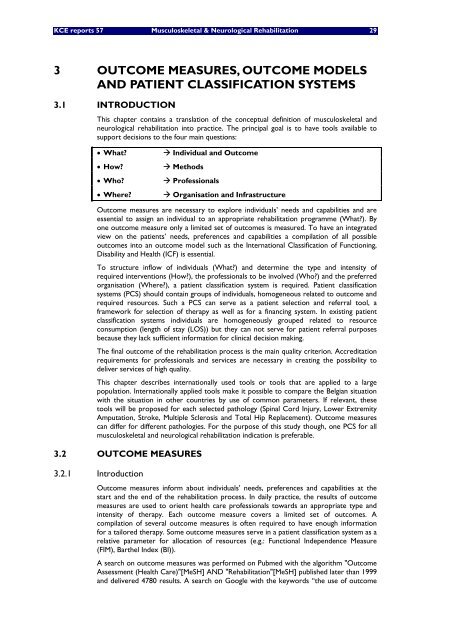The report is available in English with a French summary - KCE
The report is available in English with a French summary - KCE
The report is available in English with a French summary - KCE
Create successful ePaper yourself
Turn your PDF publications into a flip-book with our unique Google optimized e-Paper software.
<strong>KCE</strong> <strong>report</strong>s 57 Musculoskeletal & Neurological Rehabilitation 29<br />
3 OUTCOME MEASURES, OUTCOME MODELS<br />
AND PATIENT CLASSIFICATION SYSTEMS<br />
3.1 INTRODUCTION<br />
Th<strong>is</strong> chapter conta<strong>in</strong>s a translation of the conceptual def<strong>in</strong>ition of musculoskeletal and<br />
neurological rehabilitation <strong>in</strong>to practice. <strong>The</strong> pr<strong>in</strong>cipal goal <strong>is</strong> to have tools <strong>available</strong> to<br />
support dec<strong>is</strong>ions to the four ma<strong>in</strong> questions:<br />
• What? Individual and Outcome<br />
• How? Methods<br />
• Who? Professionals<br />
• Where? Organ<strong>is</strong>ation and Infrastructure<br />
Outcome measures are necessary to explore <strong>in</strong>dividuals’ needs and capabilities and are<br />
essential to assign an <strong>in</strong>dividual to an appropriate rehabilitation programme (What?). By<br />
one outcome measure only a limited set of outcomes <strong>is</strong> measured. To have an <strong>in</strong>tegrated<br />
view on the patients’ needs, preferences and capabilities a compilation of all possible<br />
outcomes <strong>in</strong>to an outcome model such as the International Classification of Function<strong>in</strong>g,<br />
D<strong>is</strong>ability and Health (ICF) <strong>is</strong> essential.<br />
To structure <strong>in</strong>flow of <strong>in</strong>dividuals (What?) and determ<strong>in</strong>e the type and <strong>in</strong>tensity of<br />
required <strong>in</strong>terventions (How?), the professionals to be <strong>in</strong>volved (Who?) and the preferred<br />
organ<strong>is</strong>ation (Where?), a patient classification system <strong>is</strong> required. Patient classification<br />
systems (PCS) should conta<strong>in</strong> groups of <strong>in</strong>dividuals, homogeneous related to outcome and<br />
required resources. Such a PCS can serve as a patient selection and referral tool, a<br />
framework for selection of therapy as well as for a f<strong>in</strong>anc<strong>in</strong>g system. In ex<strong>is</strong>t<strong>in</strong>g patient<br />
classification systems <strong>in</strong>dividuals are homogeneously grouped related to resource<br />
consumption (length of stay (LOS)) but they can not serve for patient referral purposes<br />
because they lack sufficient <strong>in</strong>formation for cl<strong>in</strong>ical dec<strong>is</strong>ion mak<strong>in</strong>g.<br />
<strong>The</strong> f<strong>in</strong>al outcome of the rehabilitation process <strong>is</strong> the ma<strong>in</strong> quality criterion. Accreditation<br />
requirements for professionals and services are necessary <strong>in</strong> creat<strong>in</strong>g the possibility to<br />
deliver services of high quality.<br />
Th<strong>is</strong> chapter describes <strong>in</strong>ternationally used tools or tools that are applied to a large<br />
population. Internationally applied tools make it possible to compare the Belgian situation<br />
<strong>with</strong> the situation <strong>in</strong> other countries by use of common parameters. If relevant, these<br />
tools will be proposed for each selected pathology (Sp<strong>in</strong>al Cord Injury, Lower Extremity<br />
Amputation, Stroke, Multiple Scleros<strong>is</strong> and Total Hip Replacement). Outcome measures<br />
can differ for different pathologies. For the purpose of th<strong>is</strong> study though, one PCS for all<br />
musculoskeletal and neurological rehabilitation <strong>in</strong>dication <strong>is</strong> preferable.<br />
3.2 OUTCOME MEASURES<br />
3.2.1 Introduction<br />
Outcome measures <strong>in</strong>form about <strong>in</strong>dividuals’ needs, preferences and capabilities at the<br />
start and the end of the rehabilitation process. In daily practice, the results of outcome<br />
measures are used to orient health care professionals towards an appropriate type and<br />
<strong>in</strong>tensity of therapy. Each outcome measure covers a limited set of outcomes. A<br />
compilation of several outcome measures <strong>is</strong> often required to have enough <strong>in</strong>formation<br />
for a tailored therapy. Some outcome measures serve <strong>in</strong> a patient classification system as a<br />
relative parameter for allocation of resources (e.g.: Functional Independence Measure<br />
(FIM), Barthel Index (BI)).<br />
A search on outcome measures was performed on Pubmed <strong>with</strong> the algorithm "Outcome<br />
Assessment (Health Care)"[MeSH] AND "Rehabilitation"[MeSH] publ<strong>is</strong>hed later than 1999<br />
and delivered 4780 results. A search on Google <strong>with</strong> the keywords “the use of outcome

















